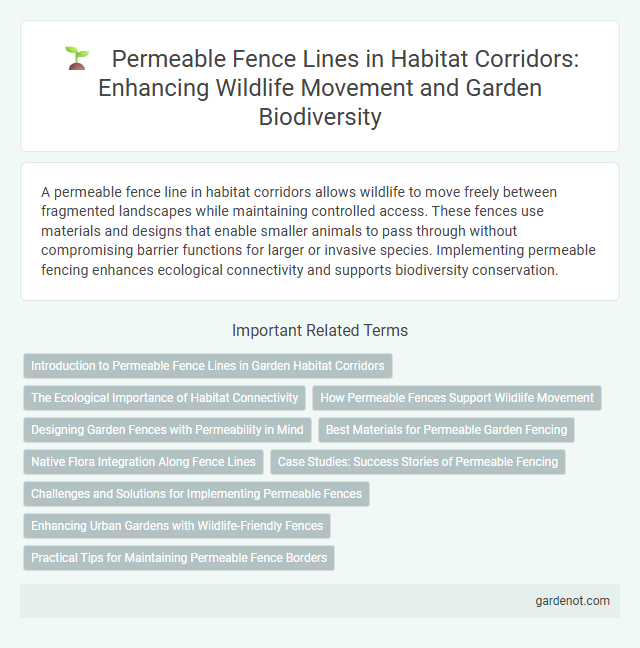A permeable fence line in habitat corridors allows wildlife to move freely between fragmented landscapes while maintaining controlled access. These fences use materials and designs that enable smaller animals to pass through without compromising barrier functions for larger or invasive species. Implementing permeable fencing enhances ecological connectivity and supports biodiversity conservation.
Introduction to Permeable Fence Lines in Garden Habitat Corridors
Permeable fence lines enhance garden habitat corridors by allowing wildlife to move freely while maintaining defined boundaries. These fences use materials like wire mesh or spaced wooden slats to enable small animals, such as amphibians, reptiles, and pollinators, to pass through safely. Incorporating permeable fences supports biodiversity by connecting fragmented habitats and promoting ecosystem resilience in urban and suburban gardens.
The Ecological Importance of Habitat Connectivity
A permeable fence line plays a crucial role in maintaining habitat connectivity by allowing the free movement of wildlife between fragmented habitats, which supports genetic diversity and reduces the risk of local extinctions. This type of fencing minimizes barriers to species migration, enabling access to vital resources such as food, water, and mating sites. By facilitating ecological flows and species dispersal, permeable fences enhance ecosystem resilience and biodiversity conservation across landscapes.
How Permeable Fences Support Wildlife Movement
Permeable fence lines enhance habitat corridors by allowing animals to pass through safely, maintaining connectivity between fragmented ecosystems. These fences reduce wildlife-vehicle collisions and support genetic diversity by facilitating gene flow among isolated populations. Designing fences with gaps or wildlife-friendly materials ensures that species of various sizes can navigate around human barriers effectively.
Designing Garden Fences with Permeability in Mind
Design garden fences with permeability to support wildlife movement and biodiversity by incorporating gaps, mesh panels, or low-height sections that allow small animals to pass through easily. Use materials such as wire mesh or spaced wooden slats that maintain structural integrity while enabling connectivity between habitat corridors. A permeable fence line enhances ecological networks by reducing habitat fragmentation and promoting safe passage for pollinators, amphibians, and small mammals.
Best Materials for Permeable Garden Fencing
Permeable garden fencing enhances habitat corridors by allowing wildlife movement while maintaining garden boundaries. Best materials for permeable fences include wire mesh, chain link, and woven bamboo, which provide durability and visibility without obstructing small animals or airflow. Incorporating natural materials like wooden slats spaced appropriately also supports permeability and promotes a thriving ecosystem.
Native Flora Integration Along Fence Lines
Permeable fence lines designed for habitat corridors enhance native flora integration by allowing uninterrupted growth and natural seed dispersal along the barriers. Incorporating native plant species such as goldenrod, milkweed, and blazing star along these fences supports pollinators and wildlife movement, improving biodiversity connectivity. These vegetated strips act as microhabitats that maintain ecosystem function while promoting genetic exchange among plant and animal populations.
Case Studies: Success Stories of Permeable Fencing
Case studies demonstrate that permeable fence lines significantly enhance wildlife movement by allowing safe passage across fragmented habitats, reducing mortality rates for species such as deer and foxes. In regions like the Australian outback, strategically installed permeable fencing has restored critical migration routes, improving genetic diversity and ecosystem resilience. These success stories underscore the importance of integrating permeable fence designs in habitat corridors to promote biodiversity conservation effectively.
Challenges and Solutions for Implementing Permeable Fences
Permeable fence lines facilitate wildlife movement by allowing species to pass through or over barriers, yet challenges include balancing security needs with permeability and mitigating maintenance complexities in variable environments. Innovative solutions involve integrating modular panels with adjustable openings, using materials resilient to weather and animal interactions, and designing adaptive monitoring systems to assess fence effectiveness. Collaborative efforts between ecologists, engineers, and land managers enhance the development of fences that reconcile habitat connectivity with human land use.
Enhancing Urban Gardens with Wildlife-Friendly Fences
Permeable fence lines in urban gardens improve habitat corridors by allowing small wildlife to safely traverse between green spaces, supporting biodiversity and ecosystem connectivity. These fences use materials and designs that enable natural movement of insects, amphibians, and small mammals while maintaining garden boundaries. Integrating permeable fencing enhances urban wildlife habitats and promotes ecological balance within city landscapes.
Practical Tips for Maintaining Permeable Fence Borders
Maintaining permeable fence borders involves regularly inspecting for debris buildup to ensure unobstructed wildlife movement along habitat corridors. Use native vegetation to reinforce fence lines, which enhances natural permeability and supports local ecosystems. Routine trimming of overgrown plants and repairing damaged sections prevent barriers that disrupt animal pathways and preserve ecological connectivity.
Permeable fence line Infographic

 gardenot.com
gardenot.com